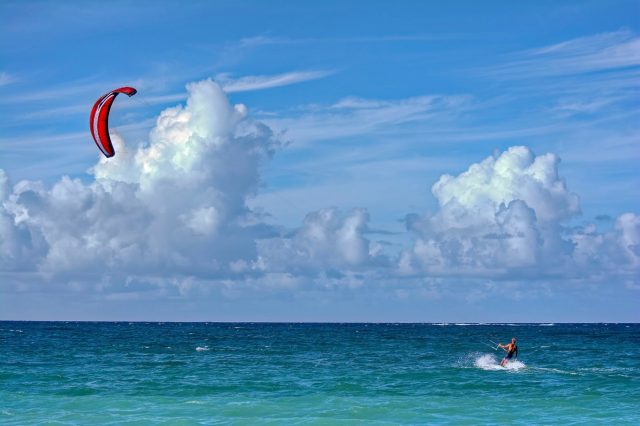Ted Rice of Marble Brewery in Albuquerque New Mexico is an avid surfer, golfer, and kiteboarder. Love watersports but want just a bit more adventure? In the article below Ted Rice explains what you need to get started in the sport of kiteboarding.
Kiteboarding uses a kite that is controlled through lines and a bar on a harness worn around the stomach. Depending on the area Ted Rice of Marble Brewery says it’s also called skyboarding and kitesurfing, but however it’s referred to, it’s a wild ride that will quickly become a favorite. Wherever windsurfing is possible, so is kiteboarding.
Ted Rice explains it’s especially great for those who feel comfortable out on the open sea. Flying the kite in certain patterns creates enough power to jump – and jump very high. Some kiteboarders (well, professionals at least) can get as high as 60 feet and float for hundreds of feet. That’s some serious airtime.
What also makes kiteboarding appealing according to Ted Rice of Albuquerque is that it’s straight-forward to get started. Here’s what’s needed to prepare for a watersport unlike any other.
The Gear
Generally, kiteboarding equipment is less pricey than gear used in windsurfing. Kites with the needed lines and bar will likely run about $950 to $1600 while boards range from $600 to $900. The jacket and harness cost about $150.
Ted Rice of Marble Brewery explains that it’s possible to score some serious kiteboarding gear deals by going with used kit; some of the sport’s enthusiasts say that it can cut the overall equipment cost in half. However, be sure to double-check the age of the gear. Never buy kiteboarding equipment than is more than three years old.
Try Out a Kite
Before kiteboarding, practice flying a two- or four-line kite, especially if it’s been a long time since learning how to fly a kite. Ted Rice of Marble Brewery says these trainer kites let people try out and explore flying skills that are needed while kiteboarding and may also prevent damage to kiteboarding equipment.
Lessons
While kiteboarding can be mastered with practice, it’s still a very technical sport that requires professional training.
Ted Rice explains that some kiteboarding techniques may seem counterintuitive at first, so lessons will help with mastering the basic concepts and avoiding mistakes. Proper lessons are the best way to ensure safety out on the water.
Consider a lesson before purchasing equipment just to be sure it’s the right fit. It’s easy to find an affordable single-day lesson that covers all the basics.
Those who then want to pursue the sports should take further lessons while they purchase needed gear and then after they’ve purchased the gear to get instruction tailored to certain equipment. A full course takes anywhere from 3 days to a week.
Ted Rice of Marble Brewery says always take a lesson from someone certified in kiteboarding instruction and someone who has been trained themselves in the sport. There are several recognized organizations that offer courses led by certified trainers and there are numerous kiteboarding camps around the world to find the best trainers and people to kiteboard with.
Some examples include Dare2Fly in the Dominican Republic or Heliophora off the west African coast in Dakhla. Ted Rice of Marble Brewery says countries ranging from Brazil and Sri Lanka to Egypt also have kiteboarding camps.
As with other sports, don’t make the mistake of thinking kiteboarding can be learned from watching videos. Yes, there are instructional lessons available online and some may offer nice insights before a first lesson, but never rely on just a video for training before getting out on the water.
What To Expect from Lessons
Ted Rice of Marble Brewery explains that beginning courses cover everything needed to start the sport right. Lessons usually go over how to fly a kite on land, including control, launching, and landing, kite flying on water, including relaunching and body dragging, and how to get up on a board and ride it effectively.
Other topics covered include how to assess whether an area offers proper kiteboarding conditions, how to determine wind direction and wind strength, and general knowledge about currents, tides, and potential water hazards.
Typically, kiteboarders need about 10 to 12 hours of training before getting out on the water.
Consider Physical Fitness Levels
Ted Rice of Albuquerque explains that kiteboarding doesn’t require exceptional fitness or even massive muscle strength, but as with most sports, it’s best to have a good general fitness level. It helps with skill progression, avoidance of injuries, and stamina out on the water and in the air.
Make Sure All the Gear is Packed
The kite, board, and harness are a must, but many recommend bringing along a wetsuit and life vest while kiteboarding. Some kiteboarding packages also include a leash, backpack, and pump, but even the standard board will include a board handle, foot straps, and fins.
Make sure everything is in order before heading to a beach. Missing an item? Don’t kiteboard.






